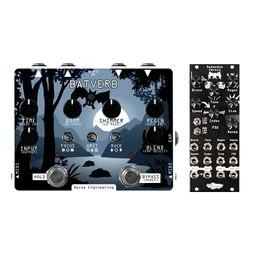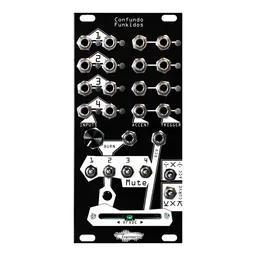Last week was Launch Week, where we launched a buncha new products. However, if you’re not glued to Instagram all the time (let’s be real, most of us are, but just in case) we’ve compiled all the announcements here in one easy-to-read spot, just for you!

First things first: Libdaisy
Are you DIY-inclined? Do you like programming? Do you own a Desmodus Versio? If you said yes to at least one of those things, this announcement may interest you! A while back, we announced that we’d eventually be setting up Desmodus Versio so that users could develop their own firmware for the platform. And now you can! We’ve added support through the open-source project LibDaisy. All the details (and a more technical explanation) are available in last week’s blog post. Head on over and start turning your Versio into… Whatever you want, really.

Customer Portal
And speaking of DV: we also launched the NE Customer Portal! Customer Portal will be home of many things to come, but right now, it’s where the Versio flash app will live. And not only is it new and fancy and pretty, if you create an account you can get a FREE ALTERNATE FIRMWARE for you Versio NOW! Yes, you read that right: FREE. NOW. ALTERNATE FIRMWARE. YES. It’s called Ampla Versio, and it’s a stereo ADSR-controlled MMF gate/VCA, and vintage-style chorus. What’s all that mean, you ask? Good question! Let’s start with the MMF gate/VCA part.
We’re fans of lowpass gates, as are most people in modular. If you’re not familiar, a lowpass gate is a combination lowpass filter and VCA, often controlled by a decay envelope generated by a vactrol. However, traditional lowpass gates usually give you, at most, a few controls (even our LPG, Sinc Bucina, is relatively complicated by traditional standards, with only three parameters). There are lots of places where they can be expanded into something more, though, and that’s what we did here: there’s a Blend control, which lets you mix between a pure VCA and a VCA+filter combo. We threw in a control for Resonance because why not? And we like lowpass gates, but why limit ourselves? So we added a switch to let you choose lowpass, bandpass, or highpass filter.
Of course, we didn’t stop there! A lot of lowpass gates only give you a decay envelope, but we decided to go all out with a full ADSR envelope. The envelope also has a dedicated curve control, so you can change the envelope slopes from logarithmic to linear to exponential. The curve control, as well as the ADSR parameters, are all voltage controllable, too. The VCA/filter signal path is completely stereo, too, so you can use it to control dynamics for a mono source, or multiple oscillators in stereo, a stereo source, or whatever you want, really.
Whew. We did all that and looked at the Versio hardware and realized we have One. More. Switch. We wanted to do something cool with it -- so we added a chorus inspired by vintage choruses that we all know and love and it kinda makes anything you put into it sound cool. There are three settings: off, slow chorus, and speedy chorus. It can also do mono-to-stereo, so if you patch a mono sound to the L input and activate the chorus, you’ll get some awesome stereo results at the L and R outputs.
You can flash AV onto your Versio at the customer portal here: portal.noiseengineering.us
And check out the full AV manual here.

Fractio Solum
Remember forever ago when we announced Fractio Solum? No? It’s ok, it’s been a while.
However, FS wasn’t forgotten, it’s just been very, very delayed, for many reasons; some good, some just 2020.
We think it was worth the wait, though: FS is a lot of fun. If you didn’t see our coverage of FS when we first showed it, it’s a voltage-controllable clock divider and multiplier that gives you a huge variety of clock ratios and a number of interesting outputs in a tiny and pretty cool looking 4 HP package. The display is pretty user-friendly, too: for every number of triggers in (bottom number), the top displays how many triggers FS send to the Out jack.
FS has clock and reset inputs to keep you synced to whatever you want to sync to, and four outputs. Out, the main output, outputs exactly what you see on the Ratio display. x2 and /2 output at rates double and half the main Out jack respectively, so you have some extra variation from your divisions. Finally, BOC fires every time a clock cycle starts, based on the slowest /2 output. It’s CVable, so you can modulate your clock rates which is FAR more fun than I ever could have guessed. You can also tap the encoder to mute the outputs, so if you’re sequencing something with FS it gives you another layer of performance control. Use FS for all your polyrhythm and crazy meter needs. Kris once did a set with three FS triggering 6 BIA. It’s good times.
We’ll be doing a deep dive into FS here on the blog soon, so keep an eye out for that. You can order your FS at our webshop, and take a look at the full manual on the shop page, too.

The big one: Imitor Versio
You didn’t think we were done with the Versio news, did you? Not only did we release a free firmware update for all Versio modules, we also introduced Imitor Versio, the newest module in the Versio series. While Ampla is a freebie available as firmware only, Imitor Versio gets a full release with a new panel, too. But if you already have a Desmodus, you’re in luck: you can also flash the Imitor firmware onto it and give it a try NOW. Those of us that’re particularly proficient in math may have realized that means that if you bought ONE Desmodus Versio, it can now be THREE DIFFERENT MODULES. Three for one. I put that into my calculator and it made a happy face.
Imitor Versio is a twelve-tap stereo delay. If you’ve never used a multitap delay before, it’s a bit different from what you may think of if you’re used to, say, BBD-style delays. With feedback at minimum, each sound you input gets repeated twelve times (hence the “twelve tap” descriptor). This may sound unusual at first glance, but the controls on IV are designed to manipulate how those twelve taps play with each other. You can set them to be equal volume, crescendo, or decrescendo; they can be set to different rates of deceleration or acceleration, and you can change their panning in relationship to each other for some wild stereo effects. Of course, it doesn’t stop there: the LFO parameter adds modulation and filtering to the delay taps, giving vintage delay-inspired (or just completely ridiculous) tones. There’s also three delay modes, similar to the DV: LIM, a clean delay; DST, a slightly distorted delay; and SHM, a pitch-shifting delay. Finally, the Regen control lets you repeat those twelve repeats, and turning the regen parameter fully clockwise activates ducking based on the input audio.
We’ll also be doing a deep dive on the IV on the blog soon, but you can watch the demo video below and check out the shop page, read the manual, and even flash the IV firmware to your Versio now.
World of Versio
There’re a lot of different Versio stuff to look at now, and way more coming, so we’ve made a dedicated page on the website: welcome to the World of Versio! Here, you can see all the different Versio modules, read their manuals and patchbooks, check the Customer Portal for new firmwares, download front panels to keep as a reference (or make your own custom panels), and get started writing your own firmware with the Libdaisy library. There’s a lot to do with the Versio ecosystem, and now it’s all in one centralized location for your convenience! Check it all out here: noiseengineering.us/pages/world-of-versio
So, that was a lot! We hope you’re as excited about these announcements as we are. We’ve been working really hard to bring you all these new shiny things, but of course, now that they’re out, we’ve got plenty more cooking... Yeah, we saw all that speculation on social media about UI, VV... Rest assured, we are working on them and want them in your hands! We are doing what we can to make that happen, and we’re also working on a ton more. Make sure you’re subscribed to our newsletter to get the scoop on whatever’s coming next. We’re going to go take a nap now.






